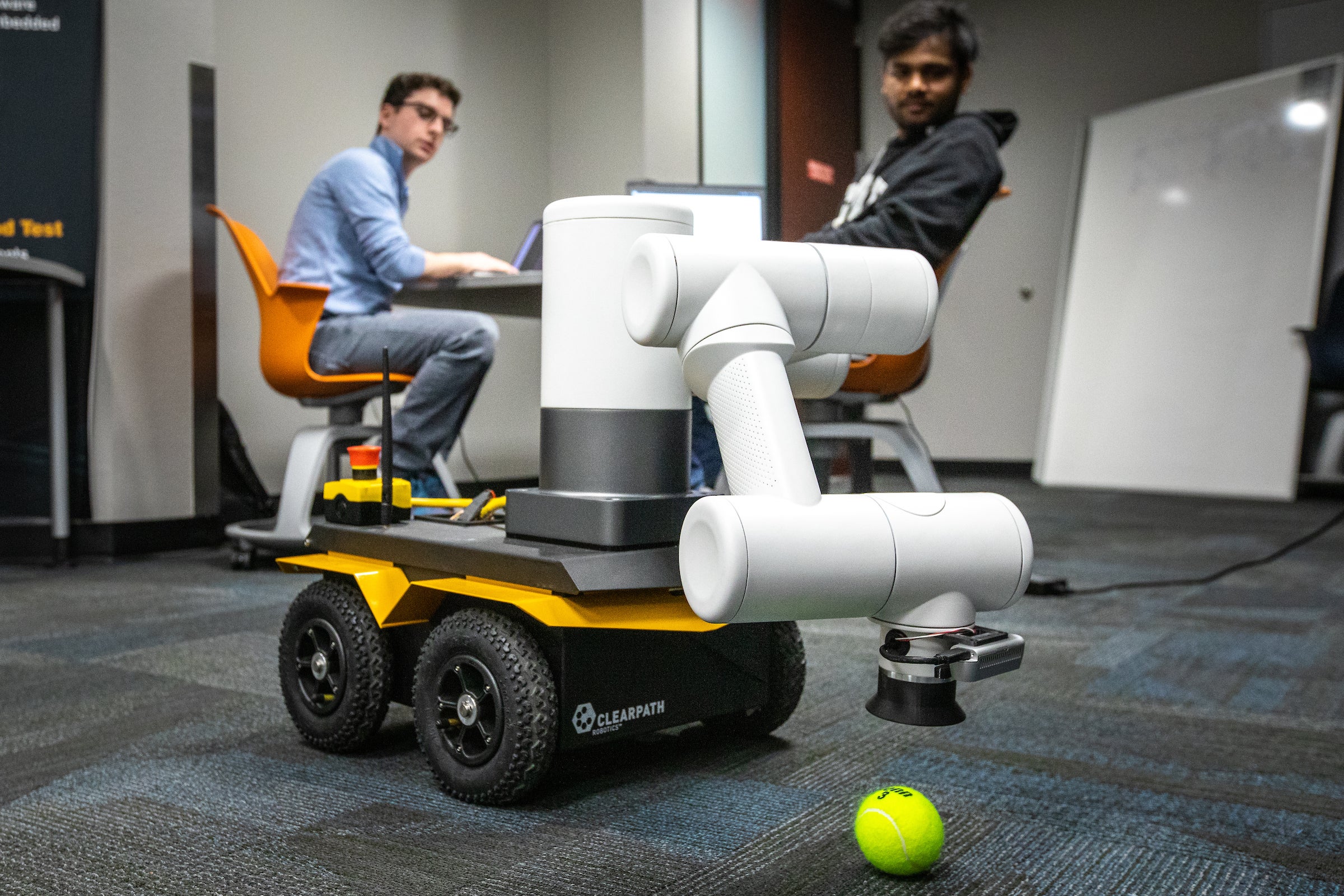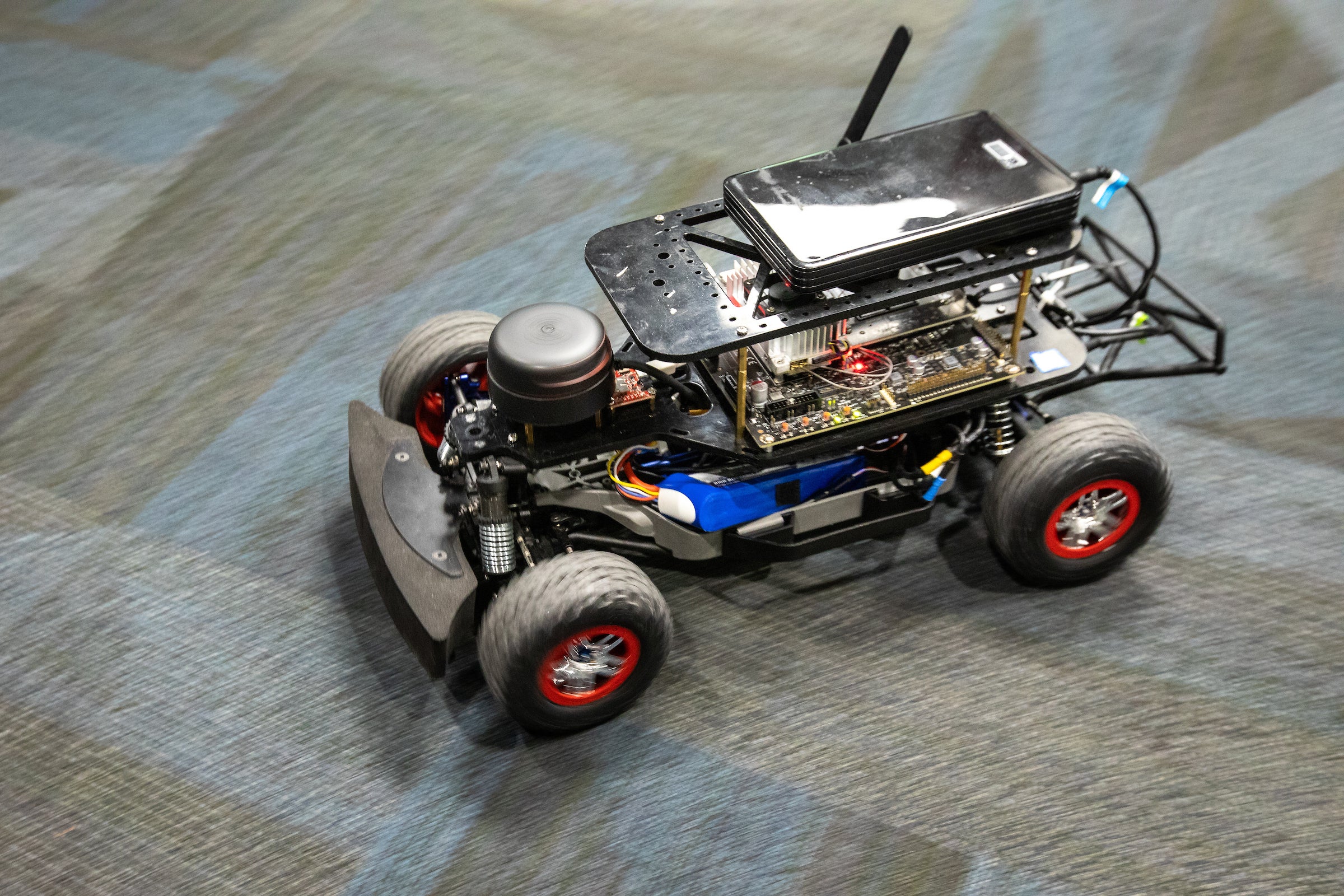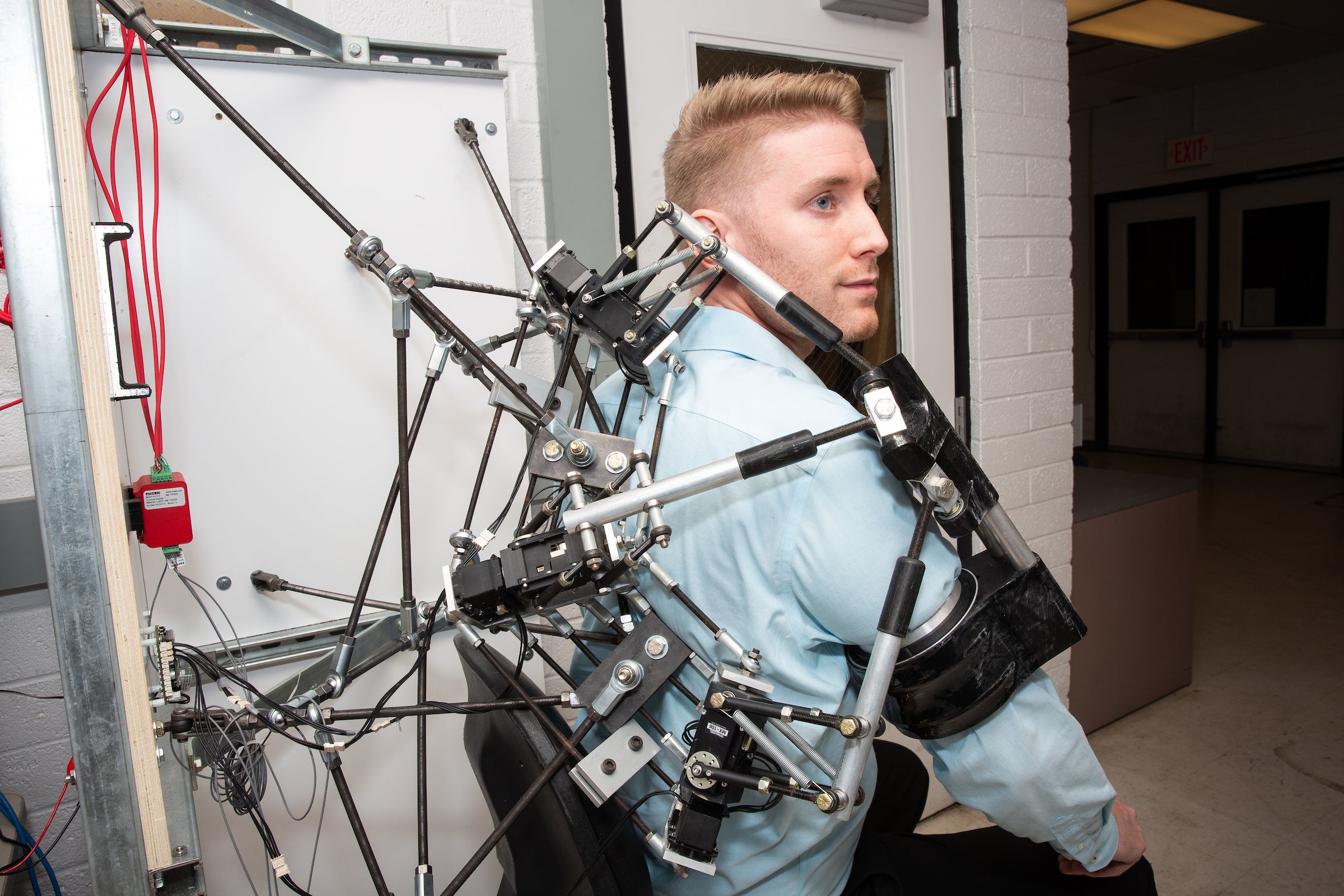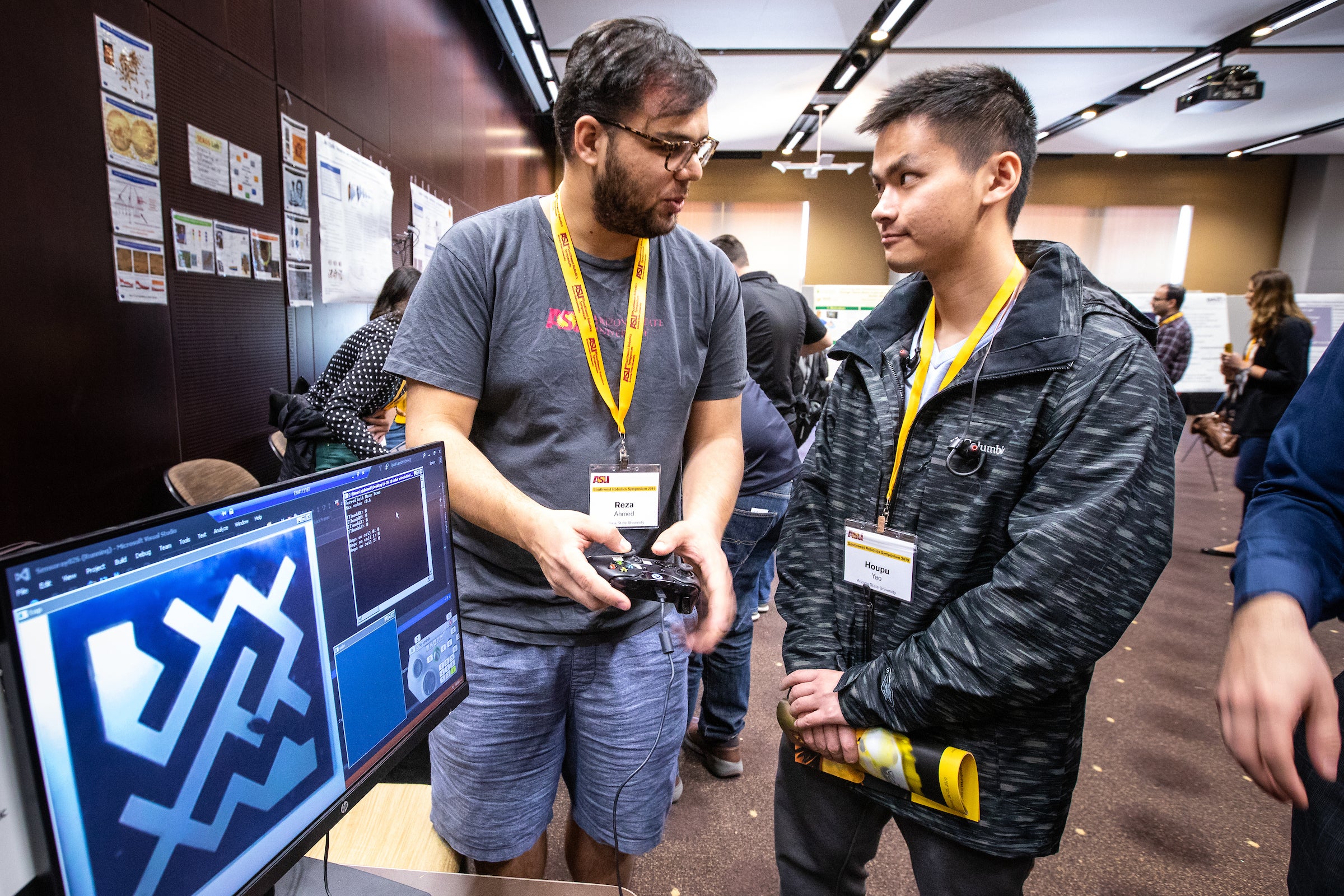Oussama Khatib, a professor of computer science at Stanford University, encountered a pivotal moment during the first outing of his deep-sea robot, Ocean One, off the coast of France. The robot was trapped, far too deep for human retrieval, between the cannons of a sunken ship. Weather was threatening to force the robotics crew to return to shore, but Khatib and his team resisted.
“No way, I’m not leaving the robot,” Khatib said before moving to the haptic controls, which simulate a sense of touch and allow for remote operation. Able to control the robot’s arms, Khatib pushed. “And the robot jumped. I was very happy.” Ocean One was freed and able to successfully continue its mission.
Khatib recounted this story as plenary speaker at this year’s Southwest Robotics Symposium, hosted by Arizona State University’s Engineering Robotics Program on Jan. 24-25. Physical human-robot interaction, abbreviated pHRI, was a continuing thread in presentations ranging from robots learning human skills to multi-robot systems and intuitive tactile haptic interaction.
Ocean One, the first robot to have a two-arm/hand sensing system, is an example of robot-human partnerships, Khatib explained.
“We can rely on the brain of the human and the muscles, eyes and sense of touch of the robot in places where humans cannot, or should not, be,” said Khatib. “For example, we will be able to safely repair underwater structures, place sensors or retrieve coral samples from ocean depths never before possible.”
Dan Pipe-Mazo of Elementary Robotics (left) and electrical engineering doctoral student Shubham Sonawani run a tennis-ball-collecting robot that Pipe-Mazo's group developed with Sonawani in the Interactive Robotics Lab, directed by Assistant Professor Heni Ben Amor. The lab participated in the Southwest Robotics Symposium. Photo by Charlie Leight/ASU Now
Advanced printing, sensing and computing technologies escalate robotics
In addition to a symposium focus on pHRI, additive manufacturing, 3D printing and rapidly advancing sensing and computing systems are transforming the world of robotics.
For example, the ability to 3D-print flexible materials has dramatically expanded the field of medical robotics, according to guest speaker Jaydev Desai, a professor from Georgia Institute of Technology.
Desai’s micro-scale, robotically actuated guidewires present a new option for procedures like cardiovascular surgery, replacing rigid, difficult-to-insert instruments with soft, jointed devices.
“Look at your finger,” Desai instructed the attendees. “Imagine a guidewire that could afford independent flexibility at any of the three joints, like your finger," he said. “This significantly enhances a surgeon’s ability to navigate a complicated pathway of arteries without causing damage along the way."
New manufacturing methods and lower costs are also raising expectations of medical practitioners, as well.
“Sometimes, you just want the basic research. Sometimes you just want to know the properties of human motion,” said plenary speaker Ruzena Bajcsy, a computer science professor at the University of California, Berkeley. “On the other hand, if you are working with a medical collaborator on the other side, those guys are asking very different questions. They are interested in how easy it is to use, how fast it is and how cheap it is.”
Bajcsy cautioned that less expensive isn’t always better, noting that it’s important for practitioners to understand that differences in device data-capture capabilities can affect therapy planning and patient outcomes.
A self-learning autonomous car cruises around the Interactive Robotics Lab on Jan. 23. Photo by Charlie Leight/ASU Now
Softer, safer robots arrive
With the advance of these new printing and manufacturing technologies, heavy, rigid robots are being replaced with lightweight, flexible new systems. As humans increasingly share workspaces with robots, these softer versions offer a higher degree of safety and increased robotic capabilities.
Soft, bio-inspired robots, which mimic animals like geckos, fish and octopuses — or humans — are able to adapt to solid, granular and fluid environments. The new materials used in the development of these robots are made possible by advanced printing and manufacturing techniques. According to Hamid Marvi, an ASU robotics professor whose research investigates the physics of biological systems, these developments will improve robotic support for search and rescue, medical applications and earth and space exploration.
Wearable robotics, like assistive and prosthetic devices equipped with patient-friendly sensing capacities, are also offering enhanced therapeutic value because of access to manufacturing improvements.
Speakers presented assistive devices for patients undergoing gait, knee, shoulder or ankle rehabilitation that rely on soft structures and are equipped with patient-friendly sensing capacities.
Doctoral student Justin Hunt demonstrates a parallel actuated shoulder exoskeleton in the Hyunglae Lee robotics lab on the Tempe campus on Jan. 24. Photo by Deanna Dent/ASU Now
“These devices can first analyze the patient’s therapeutic needs, which is used to create a therapeutic treatment plan,” said Hyunglae Lee, an assistant professor who specializes in such devices. “When these devices are used in a clinical setting, the software can be programmed to provide patient-specific treatment plans for multiple patients.”
Other assistive-device presentations centered on workplace assistance for tasks such as lifting and walking. Autonomous systems and artificial intelligence were covered in talks about the growing fields of underwater and multi-robot networks.
Wenlong Zhang, an ASU assistant professor of engineering and symposium general chair, said that in the past five years, the event’s attendance has grown along with ASU’s reputation for robotics innovation.
“ASU now has 35 faculty members across robotics disciplines and just launched a new master’s degree in robotics and autonomous systems,” he said. “For the symposium, we had more than 700 registrants and presenters considered among the top in their fields.”
This year’s symposium, which had 12 industry sponsors, featured tours of ASU robotics labs on the Tempe and Polytechnic campuses and more than 40 student poster presentations from 20 universities in the U.S., Australia, Denmark, Canada, India and Italy. The exhibit section of the symposium included both industry and ASU faculty demonstration booths. For the first time, two companies, Delsys and Nvidia, provided industry-insight presentations during the symposium.
“Our goal for the symposium is to share our current understanding of robotics and autonomous systems and provide a platform to foster innovation and collaboration between researchers,” said Zhang.
ASU engineering students Reza Ahmed (left) and Houpu Yao discuss an electromagnetic coil system that commands magnetic microrobots at the 2019 Southwest Robotics Symposium. Photo by Charlie Leight/ASU Now
Top photo: Mechanical engineering doctoral student Hosain Bagheri talks about the bio-inspired soft-terrain maneuvering robot at the 2019 Southwest Robotics Symposium on Jan. 24. Photo by Charlie Leight/ASU Now
More Science and technology

ASU professor breeds new tomato variety, the 'Desert Dew'
In an era defined by climate volatility and resource scarcity, researchers are developing crops that can survive — and thrive — under pressure.One such innovation is the newly released tomato variety…

Science meets play: ASU researcher makes developmental science hands-on for families
On a Friday morning at the Edna Vihel Arts Center in Tempe, toddlers dip paint brushes into bright colors, decorating paper fish. Nearby, children chase bubbles and move to music, while…

ASU water polo player defends the goal — and our data
Marie Rudasics is the last line of defense.Six players advance across the pool with a single objective in mind: making sure that yellow hydrogrip ball finds its way into the net. Rudasics, goalkeeper…






